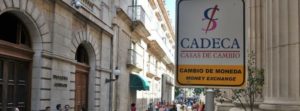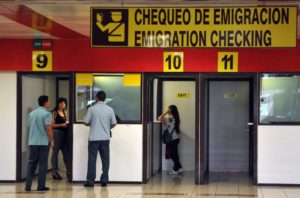 CUBANOS EN EL EXILIO ENVIARON EN 10 AÑOS $30,000 MILLONES A LA ISLA.
CUBANOS EN EL EXILIO ENVIARON EN 10 AÑOS $30,000 MILLONES A LA ISLA.
El envío de remesas en efectivo de Estados Unidos a Cuba entre 2008 y 2018 totalizó $30,000 millones, lo que convierte este activo financiero en el “salvavidas de los cubanos”, según un informe del Havana Consulting Group (THCG), con sede en Miami.
Por ello, la “mejor arma” con que cuenta la isla caribeña para “contrarrestar” la honda crisis que sacude a Venezuela es su exilio, que hoy “soporta financiera y emocionalmente a la familia cubana”, afirmó en un artículo Emilio Morales, presidente y gerente general de la citada firma, que ayuda a entender el mercado de Cuba y a sus consumidores.
Combinando los dos tipos de remesas, en efectivo y mercancías, la población cubana ha recibido de su diáspora un total de $57,269 millones en los últimos 11 años, con un promedio de $5,200 millones anuales.
Así pues, las remesas constituyen el principal activo financiero de la economía cubana no solo en volumen, respecto de sectores como el turístico, la minería, el azucarero o del tabaco, sino que suponen el 50,8 % de ingresos de la población cubana.
De hecho, los ingresos totales de remesas tienen más peso en la economía de la isla que el “intercambio comercial conjunto de Cuba con China y Venezuela”, apuntó Morales.
Esta dependencia económica de las remesas crea un “nivel de vulnerabilidad” que el gobierno cubano “no puede controlar”.
Y lo que es peor, la “escalada de sanciones de EEUU” a Cuba en el primer trimestre del año hace pensar que a medio plazo el envío de remesas “podría sufrir una fuerte desaceleración”.
Esto podría agravar aún más la crisis actual de la economía cubana, donde podría tener un peso fatal la “posible intensificación del deterioro de las relaciones entre Cuba y Estados Unidos en los próximos meses”, con “más sanciones al Gobierno cubano” por parte de la Administración de Donald Trump.
“Esto sería catastrófico para la economía cubana” y actuaría como una “guillotina en el cuello del gobierno cubano”, pronosticó Morales.
Esta situación se agravaría aún mas con la entrada en vigor del Título III de la ley Helms-Burton confirmada este miércoles.
El Título III permite reclamar en los tribunales estadounidenses propiedades nacionalizadas por el régimen cubano y demandar por daños a compañías extranjeras que han invertido en bienes comerciales expropiados en la isla.
 CUBANS IN EXILE SENT IN 10 YEARS $ 30,000 MILLION TO THE ISLAND.
CUBANS IN EXILE SENT IN 10 YEARS $ 30,000 MILLION TO THE ISLAND.
The sending of cash remittances from the United States to Cuba between 2008 and 2018 totaled $ 30,000 million, which makes this financial asset the “lifeline for Cubans,” according to a report from the Havana Consulting Group (THCG), based in Miami.
Therefore, the “best weapon” available to the Caribbean island to “counteract” the deep crisis that shakes Venezuela is their exile, which today “financially and emotionally supports the Cuban family,” said in an article Emilio Morales, president and general manager of the aforementioned firm, which helps to understand the Cuban market and its consumers.
Combining the two types of remittances, in cash and merchandise, the Cuban population has received from its diaspora a total of $ 57,269 million in the last 11 years, with an average of $ 5,200 million annually.
Thus, remittances are the main financial asset of the Cuban economy, not only in terms of volume, for sectors such as tourism, mining, sugar or tobacco, but also represent 50.8% of the Cuban population’s income.
In fact, the total income of remittances has more weight in the economy of the island than the “joint commercial exchange of Cuba with China and Venezuela,” said Morales.
This economic dependence on remittances creates a “level of vulnerability” that the Cuban government “can not control”.
And what is worse, the “escalation of US sanctions” to Cuba in the first quarter of the year suggests that in the medium term remittances “could suffer a sharp slowdown.”
This could further aggravate the current crisis in the Cuban economy, where the “possible intensification of the deterioration of relations between Cuba and the United States in the coming months” could have a fatal weight, with “more sanctions against the Cuban Government” on the part of the Administration of Donald Trump.
“This would be catastrophic for the Cuban economy” and act as a “guillotine in the neck of the Cuban government,” predicted Morales.
This situation would be further aggravated with the entry into force of Title III of the Helms-Burton law confirmed on Wednesday.
Title III allows claiming in US courts properties nationalized by the Cuban regime and to sue for damages to foreign companies that have invested in commercial property expropriated on the island.
Agencies/ EFE/ Internet Photos/ Arnoldo Varona/ www.TheCubanHistory.com
THE CUBAN HISTORY, HOLLYWOOD.



 < CUBANS IN EXILE sent in 10 years $30,000 Million to the Island.
< CUBANS IN EXILE sent in 10 years $30,000 Million to the Island.



